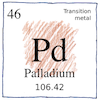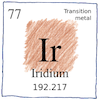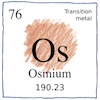







| William Hyde Wollaston, Smithson Tennant elements |
Known as an impurity in silver ore by the pre-Columbian people of America, the ore of platina was thought to be immalleable, and impossible to melt. William Hyde Wollaston and Smithson Tennant, however, smuggled platinum ore from South America, and treated it with aqua regia. This dissolved most of it. Wollaston investigated the soluble portion, which contained platinum, rhodium, and palladium. Tennant investigated the insoluble portion, a black powder, which contained iridium and osmium.
Wollaston dissolved platinum ore in aqua regia and added ammonium chloride to remove most of the platinum. He added zinc to the filtrate, which precipitated the residual platinum along with small amounts of palladium, rhodium, copper, and lead. He removed the copper and lead by dissolving the residue in nitric acid, and dissolved the rest in more aqua regia. He added sodium chloride and evaporated the solution to give the rose-red chlorine compound whose color gave it its name. After extracting this with hot alcohol, he added zinc to precipitate the rhodium.
After treating platinum ore with aqua regia and obtaining an insoluble black powder, Tennant heated the powder with sodium hydroxide until it was red hot. He cooled the melt and dissolved the resulting mass in water to obtain a yellow solution with a very pungent smell. On acidification the solution gave a white volatile oxide, osmium tetroxide, which he distilled from the solution.
Wollaston proved that static electricity is the same as electricity from a Voltaic pile. He contributed to Faraday’s invention of the first electric motor. He was the first to observe Fraunhofer lines in the solar spectrum. He invented the camera lucida, used as a drawing aid by artists. He invented the first lens specifically for a camera called a meniscus lens. He invented the reflecting goniometer to measure the angles of crystals. He invented the Wollaston prism to separate unpolarized light into polarized components. Unrelated to his work, wollastonite and pseudowollastonite, useful chain silicate minerals, are named after him.
Wollaston named rhodium after the color of its chlorine compound. Wollaston first called palladium ceresium after the recently discovered asteroid Ceres, but changed his mind named it after the asteroid Pallas. Louis Nicolas Vauquelin proposed pténe as a name for osmium, from the Greek word for winged, but Tennant named osmium because of its ashen and smoky smell from the Greek word for smell, and he named iridium because of the colors of its compounds after the Latin word for rainbow.
In 1807, Jędrzej Śniadecki might have isolated the sixth platinum group metal, ruthenium, which he called vestium. In 1827, Gottfried Osann thought he had isolated it, along with two other unknown metals, pluranium and polinium, and proposed a name for it based on Ruthenia, the area of Eastern Europe occupied by the Rus’ people. In 1844, Karl Ernst Claus not only isolated it but also determined its chemical properties and atomic weight, 44. The atomic weight of rhodium is 45, palladium 46, osmium 76, iridium 77, and platinum 78.
See also in The book of science:
Readings in wikipedia:
Other readings: